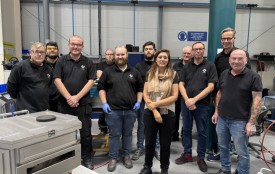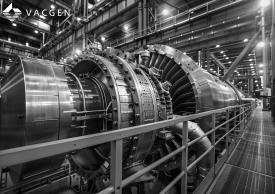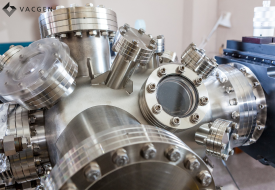Synchrotron science shines across disciplines, illuminating a pathway for scientific discoveries. Synchrotrons use synchrotron radiation, which is produced when charged particles, typically electrons, are accelerated to nearly the speed of light in a circular or spiral path by strong magnetic fields. This process generates intense beams of light that cover a broad spectrum, from infrared to X-rays.
Synchrotron facilities are large, sophisticated research facilities with the principle structure comprising of 5 main components: the linac, the booster ring, a storage ring, beamlines and end stations. The initial stage of acceleration takes place in a linear accelerator or Linac. Within the linac, particles are accelerated to moderate energies using electromagnetic fields. The particles are then ejected into the booster ring, which is a circular pre-accelerator, where the electrons are accelerated to an energy of around 6 billion electron-volts (6 Gev) before being injected into the storage ring.
The main storage ring is maintained at very low pressure, typically 1x10-9 mbar and is the central component of the facility. It is a large circular structure with a circumference that can be several kilometers long. The main ring contains powerful magnets and radiofrequency (RF) cavities. As the electrons travel around the ring, they pass through different magnet structures and in the process produce X-Rays and other intense light then utilised for experiments within the beamline end stations.
Vacuum technology is central to many of these experiments, ensuring the most accurate results for the beam line users and their applications. Some key aspects and applications of synchrotron science include:
Structural Biology: Synchrotron radiation is widely used in structural biology to study the three-dimensional structures of biological molecules. Techniques such as X-ray crystallography and cryo-electron microscopy benefit from the intense and focused beams produced by synchrotron sources.
Materials Science: Researchers use synchrotron radiation to investigate the structure and properties of materials at the atomic and molecular levels. This includes studying the behavior of materials under different conditions, such as extreme temperatures and pressures.
Medical Imaging and Therapy: Synchrotron X-rays are employed in medical imaging techniques, providing high-resolution images for diagnostics. Additionally, synchrotron radiation can be used in cancer treatment through techniques like synchrotron radiation therapy.
Environmental Science: Synchrotron techniques contribute to environmental research by analysing pollutants, studying soil composition, and investigating the interactions between pollutants and living organisms.
Physics: Synchrotron radiation is a powerful tool for studying fundamental physics phenomena. Researchers use it to investigate particle physics, condensed matter physics, and other areas of interest.
Chemistry: Synchrotron techniques aid in the study of chemical reactions, molecular structures, and the electronic properties of molecules. This is valuable for understanding chemical processes and designing new materials.
Geology and Earth Sciences: Synchrotron techniques help in analysing geological samples, studying mineral compositions, and understanding Earth's processes. This includes investigations into the behavior of materials under extreme pressure and temperature conditions.
Synchrotron facilities are major scientific infrastructures that require substantial investment and collaboration among researchers and institutions. Some well-known synchrotron facilities include Diamond Light Source in the UK, the European Synchrotron Radiation Facility (ESRF), the Advanced Photon Source (APS) in the United States, and the SPring-8 facility in Japan. These facilities play a crucial role in advancing scientific knowledge across a wide range of disciplines.
Vacuum technology plays a critical role in synchrotron facilities, ensuring that the particle beams can travel through the accelerator ring and beamlines with minimal interactions with air molecules. Maintaining a high-quality vacuum is essential for the stability and efficiency of synchrotron operations. Quadrupole magnets and other magnetic devices are used to focus and defocus the particle beams as needed to keep them on the desired trajectory. Here are some key aspects of vacuum technology used in synchrotrons:
Ultra-High Vacuum (UHV): Synchrotron accelerators and beamlines typically operate under ultra-high vacuum conditions, often achieving base pressures of 1x10-9 to 1x10-12 mbar. Achieving and maintaining UHV is crucial to minimise the scattering and absorption of synchrotron radiation by air molecules.
Vacuum Chambers: The entire accelerator ring and beamlines are enclosed in vacuum chambers to create the low-pressure environment necessary for the unimpeded travel of charged particles. These vacuum chambers are constructed from materials that are compatible with UHV conditions.
Beamline Vacuum: Beamlines, where researchers conduct experiments using synchrotron radiation, also require vacuum systems. These vacuum systems are crucial to prevent interactions between the synchrotron beam and air molecules, ensuring the accuracy of experimental measurements.
Beam Pipe Design: The design of the beam pipes, which guide the accelerated particles around the accelerator ring, is crucial for maintaining the vacuum. Smooth and expertly welded beam pipes ensure the stability of the particle beams.
Beamline Stations: Beamline stations include a variety of optical elements, such as mirrors, monochromators, and lenses, which are used to manipulate and control the synchrotron beam. Mirrors can reflect or focus the beam, monochromators select specific wavelengths of radiation, and lenses can further focus the beam.
X-Ray Optics: The X-Ray optics are designed to modify the raw incoming x-ray beam provided by the accelerator. Specialised mirrors and crystal optics focus the beamline to the desired wavelength or energy required for the experiment. Synchrotrons often feature insertion devices like wigglers and undulators. These devices create intense beams of synchrotron radiation by causing the accelerated particles to move in a sinusoidal pattern, emitting X-rays and other forms of radiation. Diagnostic instruments are placed throughout the facility to monitor the properties of the particle beams, ensuring they meet the desired specifications.
Sample Manipulation: 5 axis complex manipulators are required to manipulate the samples under vacuum conditions. These research instruments provide heating and cooling of the sample, as well as being aligned with the analyser and incoming x-ray beams. The experiment cabin houses the sample environment and detectors which are used for the analysis. The incoming energy may vary depending on the application and be between 10ev (ARPES) to 1486ev (XPS) up to 10KEV (HAXPS).
Pumps: Various types of vacuum pumps are employed to achieve and maintain the required vacuum levels. Turbo molecular pumps, ion pumps, and cryogenic pumps are commonly used in synchrotron facilities. These pumps work together to remove gas molecules from the vacuum chamber efficiently.
Specialised Viewports: Specialised viewports are used to maintain the vacuum while allowing the radiation to pass through. These windows are designed to be as transparent as possible to the specific wavelengths of synchrotron radiation. Lead glass disks are utilised to minimise the effects of the radiation on the users.
Vacuum Monitoring and Control Systems: Advanced vacuum monitoring and control systems are implemented to continuously monitor the vacuum conditions in various parts of the synchrotron facility. These systems help operators maintain the desired vacuum levels and respond to any issues promptly.
The use of vacuum technology in synchrotrons is a critical aspect that enables the production and utilisation of intense synchrotron radiation for a wide range of scientific experiments in various disciplines. With over 50 years’ experience supplying vacuum chambers, sample manipulation devices, beam scraper devices, beam choppers and adjusters, and lens assemblies engineered to the highest specifications to global research facilities, you can trust VACGEN for your next synchrotron science project.
Our continued commitment to the research industry has ensured hundreds of users around the globe benefit from VACGEN’s vacuum technology. Contact us today to see how we can help you take the next leap forward.








